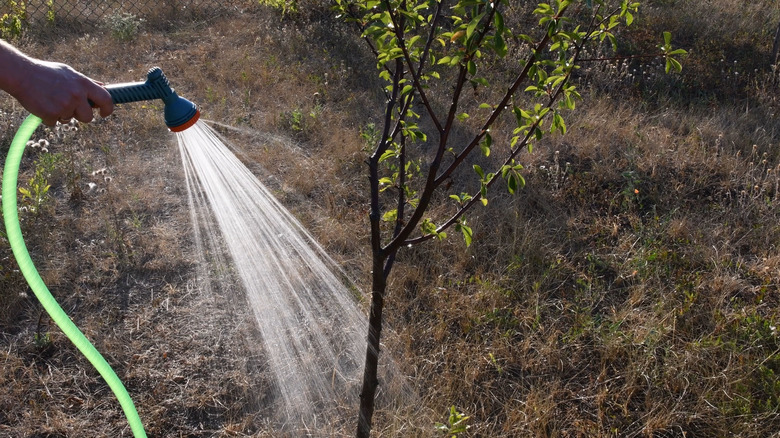Are You Watering Your Cherry Tree Enough To Prepare For Winter Months?
When the leaves on your cherry tree start turning colorful in the fall, you might think your gardening responsibilities are over for the season. In fact, the period between the end of the harvest season and the first hard freeze might be the most important time to take care of these trees. Are you watering your cherry tree (Prunus spp.) enough to prepare for the winter months? If you think you don't need to water your cherries after you've picked all the fruit, you probably aren't. These typically deciduous fruit trees need gallons of water in the fall to help them store moisture and nutrients in preparation for dormancy. The effort is worth it. Aside from producing fruit for you and your family, a properly cared for cherry tree will mature into a gorgeous flowering tree that'll attract birds to your yard.
Unfortunately, you can't rely on rainfall, especially in areas with dry fall months. Cherry trees grow best in USDA Hardiness Zones 4 to 7 (though this can vary depending on the cultivar), meaning in many places, the ground will freeze. Why is giving your cherry tree a deep watering at this specific time of year — between harvest and first frost — so vital? Once the soil freezes, the roots can't take up moisture, even if there's snow on the ground. Watering frozen ground can harm the tree's root system, too. Early fall is one of the best times to plant a cherry tree. You need to water both established and newly planted trees liberally.
Cherry trees need a moist fall to prevent winter damage
Well-hydrated trees are more resilient to the stresses of cold weather. Water plays an important role in the cells of the plant, helping insulate them and reducing the chance of freezing damage. When a tree is under-hydrated going into winter, it's vulnerable to desiccation — or drying out. This happens when the tree loses moisture faster than the roots can absorb it from icy soil. Giving your cherry tree deep waterings in the fall builds up its reserves so it can counteract this effect. However, be sure not to overwater the tree, which can smother the roots and cause root rot.
Taking the time to properly water your cherry tree in the fall keeps it healthier over winter and into the growing season. Abundant fall hydration is also vital because cherry trees continue to absorb important nutrients from the soil into the cooler months. The tree draws on this stockpile for survival over the winter months. The moist soil surrounding the roots also helps to protect the tree. It holds onto heat better than dry soil, meaning freezes don't penetrate as deeply underground and the roots are protected from injury.
How to water a cherry tree before the first deep freeze
Giving your cherry tree the right amount of water to help it through the winter is primarily about technique and timing. You don't just turn on a sprinkler. You need the water to soak deep into the soil to a depth of about 12 inches. Instead of frequent, light waterings, focus on lengthy sessions that flood the soil. Using a soaker hose, spray wand, or drip irrigation for extended periods will help the water reach the deepest roots. A good estimate is about 10 gallons of water for every 1 inch of trunk diameter per watering. Measure the trunk diameter about 6 inches above the soil line for accuracy.
Start watering deeply in the early fall, especially during dry periods, and don't stop until the ground temperature drops to freezing. A good rule of thumb is to water only while the air temperature remains above 40 degrees Fahrenheit. If possible, water in the middle of the day so the top layers of the soil can dry out before nighttime. This prevents harm to your cherry tree's root system, protecting the vulnerable smaller roots closer to the soil surface, while keeping moisture levels high for a healthy dormancy. A tree that transitions into winter in dry conditions will struggle to survive. If you have a variety of cherry trees that grows in colder climates, proper watering is particularly important.


